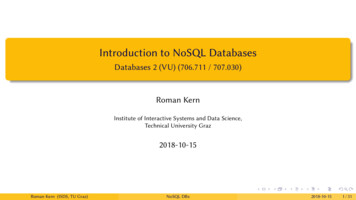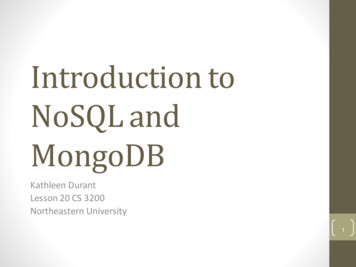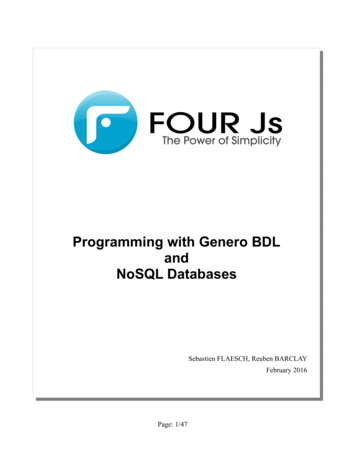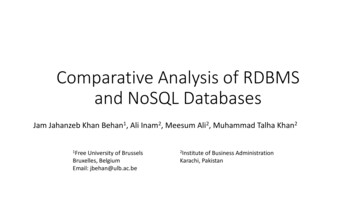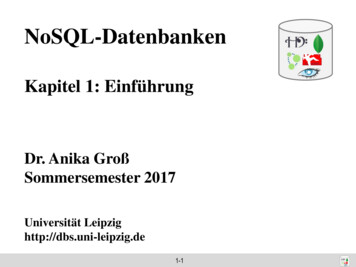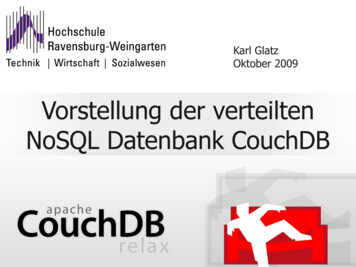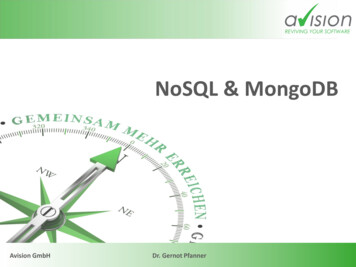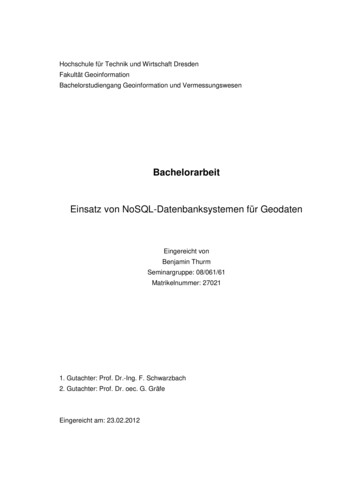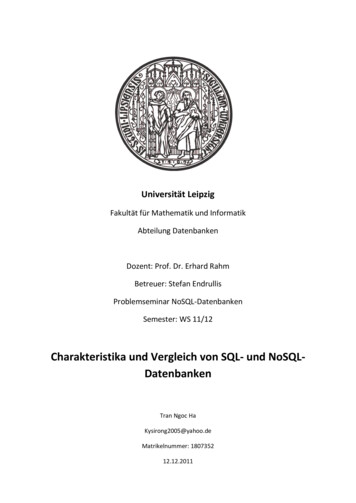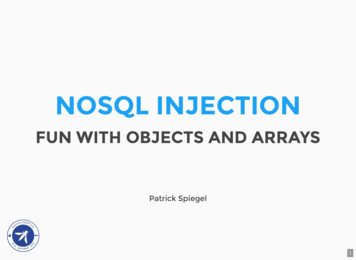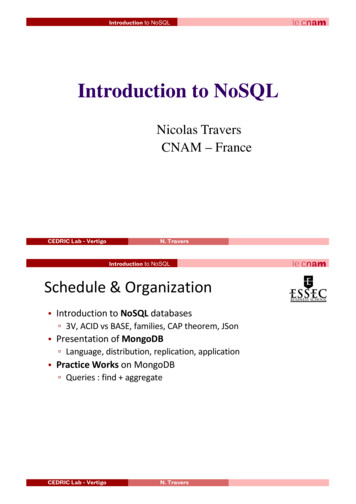
Transcription
Introduction to NoSQLIntroduction to NoSQLNicolas TraversCNAM – FranceCEDRIC Lab - VertigoN. TraversIntroduction to NoSQLSchedule & Organization Introduction to NoSQL databases 3V, ACID vs BASE, families, CAP theorem, JSon Presentation of MongoDB Language, distribution, replication, application Practice Works on MongoDB Queries : find aggregateCEDRIC Lab - VertigoN. Travers
Introduction to NoSQLDBMS vs NoSQLCEDRIC Lab - VertigoN. TraversIntroduction to NoSQLContext Applications and Web platforms Exponential growth of the amount of Data (x2 / 2 years) Unprecedent management of this volume Need to distribute both computation and data Huge number of servers Heterogeneous data, maybe complex and often linked Ex : Google, Amazon, Facebook Google DataCenter : 5000 servers/data center, 1M de servers Facebook : 1 PetaBytes of dataCEDRIC Lab - VertigoN. Travers
Introduction to NoSQLCEDRIC Lab - VertigoN. Travers8Introduction to NoSQLBI : Traditional methodsCEDRIC Lab - VertigoN. Travers9
Introduction to NoSQLDecisional vs 3VIncompatible classical approach with the 3V of BigData : Volume: Designed to store GB/TB of data, but needsPB (maybe EB). Variety: Heterogeneous and variable types of data,text, semi-structured Velocity: Data are produced more and more quicklyCEDRIC Lab - VertigoN. TraversIntroduction to NoSQLDBMS: Limitations Standard databases Functionalities Joins between tables Complex queries Strong coherency of dataØRequirements in a distributed context Links between entities same server links difficulties for data organizationCEDRIC Lab - VertigoN. Travers10
Introduction to NoSQLDBMS: Limitations (2) ACID properties for transactions Set of operationsAtomicity (integral completion or none)Consistency (consistent at start and end)Isolation (no communication between them)Durability (an operation cannot be reversed)Pessimistic view on consistencyØRequirements in a distributed context Difficulties in insuring those properties Conflict with efficiency / performancesCEDRIC Lab - VertigoN. TraversIntroduction to NoSQLACID vs BASE Modern systems use the BASE model Optimistic view on consistency Basically Available: Any request An answer Even in a changing state Soft State: Opposite to Durability. System’s state (servers or data) could change over time(without any update) Eventually consistent: With time, data can be consistent Updates have to be propagatedCEDRIC Lab - VertigoN. Travers
Introduction to NoSQLSolution: NoSQL NoSQL : Not Only SQL New data storage/management approach Scales up the system (through distribution) Complex metadata management No schemaØ Do not substitute DBMS, dedicated to: Very huge volume of data (PetaBytes) Very short response time Consistency is not mandatoryCEDRIC Lab - VertigoN. TraversIntroduction to NoSQLDatabases and NoSQLCEDRIC Lab - VertigoN. Travers
Introduction to NoSQLNoSQL DB: Characteristics No relations Collections No fix structures (nay none) Complex data (e.g. documents) Objects, nesting, arrays Data distribution High parallelization (Map/Reduce) Data replication Disponibility vs Consistency (no transactions) Few writes, many readsCEDRIC Lab - VertigoN. TraversIntroduction to NoSQLSharding : Scalability Datablocks are distributed in a cluster of servers Horizontal partitioning 3 types of technics:1. Resource allocation based: HDFS2. Tree-based structure: Clustered index (sort)3. Hash-based structure: Consistent HashingCEDRIC Lab - VertigoN. Travers17
Introduction to NoSQLNoSQL SystemsCEDRIC Lab - VertigoN. TraversIntroduction to NoSQLSeveral NoSQL systems Key-Value Store Data are identified by a unique key (used for querying) DynamoDB, Voldemort, Redis, Riak, MemcacheDB Column data Relation 1-n “one-to-many” (messages, posts) HBase, Hypertable, Spark, Elasticsearch Documents Complexes data, attributes/values MongoDB , Cassandra, CouchDB, Terrastore Graphs Highly connected entities, Social Networking Neo4j, OrientDB, FlockDBCEDRIC Lab - VertigoN. Travers
Introduction to NoSQLI - NoSQL & Key-Value store Similar to a distributed “HashMap” Key Value No fixed schema on values (strings, object, integer,binaries ) Drawbacks: No structures nor typing No structured-based queriesØ DynamoDB (Amazon), Redis (VMWare), Voldemort(LinkedIn)CEDRIC Lab - VertigoN. TraversIntroduction to NoSQLI - NoSQL & Key-Value store (2) CRUD Operations (HTTP) key) Horizontal scaling(partitionning/distribution) No vertical distribution(data segmentation)CEDRIC Lab - VertigoN. Travers
Introduction to NoSQLI - NoSQL & Key-Value store (3)CEDRIC Lab - VertigoN. TraversIntroduction to NoSQLII – NoSQL & Columns Column-based storage DBMS: tuples (lines) Easy to insert a new column Dynamic schemaØBigTable/Hbase (Google), Cassandra(Facebook&Apache), SimpleDB (Amazon)CEDRIC Lab - VertigoN. Travers22
Introduction to NoSQLII – NoSQL & Columns (2) Advantages: XML/JSon support Column indexing Horizontal scaling Drawbacks: Hard to query complex data Difficult for linked data (distances, paths, time) Pre-defined queries (not on the fly)CEDRIC Lab - VertigoN. TraversIntroduction to NoSQLII – NoSQL & Columns (3)CEDRIC Lab - VertigoN. Travers25
Introduction to NoSQLIII – NoSQL & Documents Based on the key-value store Add semi-structured data (JSon/XML) HTTP API More complex than CRUDØMongoDB, CouchDB (Apache), RavenDB, TerrastoreCEDRIC Lab - VertigoN. TraversIntroduction to NoSQLIII – NoSQL & Documents (2) Document management Simple types (Int, String, Date) No fix schema (docs may vary) Nested data Advantages: Richness for queries Indexing several attributs Easy to scale up Drawbacks: Difficulties for data interconnexions Dedicated to key-value (id)CEDRIC Lab - VertigoN. Travers
Introduction to NoSQLIII – NoSQL & Documents (3)CEDRIC Lab - VertigoN. TraversIntroduction to NoSQLIV – NoSQL & Graph Storage: nodes, relations and properties Graph TheoryPath querying on the graphData are loaded on demandDifficulties for modelingØNeo4j, OrientDB (Apache), FlockDB (Twitter)CEDRIC Lab - VertigoN. Travers
Introduction to NoSQLIV – NoSQL & Graph (2) Available storage Object (cf. documents) Edges (with properties) Difficult for ShardingCEDRIC Lab - VertigoN. TraversIntroduction to NoSQLIV – NoSQL & Graph (3)CEDRIC Lab - VertigoN. Travers31
Introduction to NoSQLCEDRIC Lab - VertigoN. TraversIntroduction to NoSQLBrewer’s CAP Theorem (2000) 3 main properties for distributed management1. Consistency: A data have the same value at the same time (coherency)2. Availability: Even if a server is down, data is available3. Partition Tolerance: Even if the system is partitioned, a query must have an answer(unless for global failures)Ø Theorem: A distributed, networked system canhave only two of these three properties.CEDRIC Lab - VertigoN. Travers
Introduction to NoSQLCEDRIC Lab - VertigoN. TraversIntroduction to NoSQLCEDRIC Lab - VertigoN. Travers
Introduction to NoSQL Initially XML used for complex internetcommunications (Web Services) Too verbose JSON (JavaScript Object Notation) Lightweight, text-oriented, language independent Used for several Web services (Google API, TwitterAPI)CEDRIC Lab - VertigoN. TraversIntroduction to NoSQLJSon : Structures Key Value “lastname” : “Travers” Keys with quotations Objects/documents Collection of key/values { “lastname” : “Travers”,“firstname” : “Nicolas”,“kind” : 1}CEDRIC Lab - VertigoN. Travers
Introduction to NoSQLData types Scalar : String, Integer, float, boolean, null List : arrays [ ] Documents : objetcs { }CEDRIC Lab - VertigoN. TraversIntroduction to NoSQLArrays No typing inside arrays “lessons” : [“SQL”, 1, 4.2, null, “NoSQL”] Can nest documents “doc” : [ {“test” : 1},{“test” : {“nesting” : 1.0}},{“key” : “text”, “value” : null}]CEDRIC Lab - VertigoN. Travers
Introduction to NoSQLJSon : Identifiers Key « id » commonly used to identify documents Overwrite already stored ids Can be automaticaly generated Ex MongoDB : " id" : ObjectId(1234567890)CEDRIC Lab - VertigoN. TraversIntroduction to NoSQLJSon : complete example{“ id” : 1234,“lastname” : “Travers”, “firstname” : “Nicolas”,“work” : {“company” : “Cnam”,“location” : {“street” : “2 rue conté”,“city” : “Paris”,“zip” : 75141},},“fields” : [ “DB” , “DB tuning”, “XML”, “NoSQL”, “IR” ]}CEDRIC Lab - VertigoN. Travers
HBase, Hypertable, Spark, Elasticsearch Documents Complexes data, attributes/values MongoDB, Cassandra, CouchDB, Terrastore Graphs Highly connected entities, Social Networking Neo4j, OrientDB, FlockDB. Introduction to NoSQL CEDRIC Lab -Vertigo N. Travers I -NoSQL & Key-Value store Similar to a distributed “HashMap” Key Value No fixed schema on values (strings, object .
